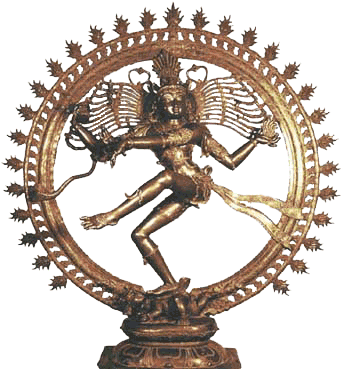|
Shiva Nataraja
"If a single icon had to be chosen to represent the extraordinarily rich and complex cultural heritage of India, the Shiva Nataraja might well be the most remunerative candidate. It is such a brilliant iconographic invention that it comes as close to being a summation of the genius of the Indian people as any single icon can."
Metropolitan Museum of Art Wikipedia: "Nataraja (literally, The King of Dance) is the dancing posture of Lord Śiva, the aspect of God as the Destroyer in Hinduism. The upper right hand holds the drum (called Udukkai in Tamil and Dhamarukha in Hindi), which symbolizes sound originating creation. The upper left hand contains Agni or the fire, which signifies destruction. The opposing concepts in the upper hands show the counterpoise of creation and destruction. The second right hand shows Abhaya ("fear not" in Sanskrit), bestowing protection from both evil and ignorance to those who follow the righteousness of dharma. The second left points towards the raised left foot which signifies upliftment and salvation. The hand also looks like the trunk of Ganeśa, the obstacle remover, a symbol of strength. The dwarf on which Nataraja dances is a demon that symbolises ignorance in man, which is defeated by the dance of Śiva. The surrounding flames represent the manifest universe. The snake swirling around his waist is kundalini, man's inherent power. Within Lord Śiva's dancing manifestation is represented not only all of time and space, but also the primal creative force that is beyond the circle of illusion that mortals live within, all movement and vibration of the universe, and the stillness beyond all existence. The entire form of Nataraja can be seen to mirror the Hindu sacred syllable Aum (\), thus implying that Lord Śiva's dance of destruction and creation is contained within the existential principle of the Divine Sound. The image of the Lord as the Cosmic Dancer is shown at the Chidambaram Temple, an unusual fact as Śiva is depicted in an anthropomorphic form rather than in the typical non-anthropomorphic form of the linga." Wikipedia (please check for updates) See also:
And this is my favorite in Thailand: Thepanom (in German)
|


